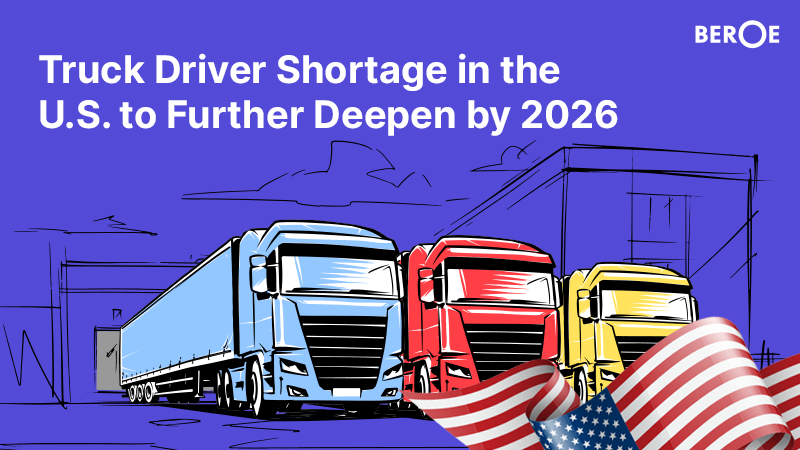Truck Driver Shortage in the U.S. to Further Deepen by 2026, Says Beroe Inc
Source: PR Newswire

RALEIGH, North Carolina, Apr 8, 2021 - The shortage in the number of truck drivers is expected to deepen in the U.S. by the year 2026 that would subsequently also influence the rates, says Beroe Inc.
There are approximately about 63,000 truck-driving jobs in the bulk tanker market that are vacant today, and the global tanker trucks market size is predicted to need 174,000 new truckers by 2026. This kind of decline affects the rates due to the capacity shortage. But the new drivers are coming up, which could radically help balance the short-term market in 2020 -21.
Beroe, which is based in North Carolina, further stated that procurement experts
can access this report on its recently launched market intelligence platform Beroe
LiVE.Ai: https://www.beroeinc.com/beroe-live-ai/
In comparison to Class 1 railroads, which employed approximately 165,000 people in 2017, the trucking industry employed more than 1.8 million drivers, a number ten times higher. The American Trucking Association estimates the current driver shortage of 63,000 could surge significantly in the next 5 years unless intervened with proper steps. The first cause for the shortage is demography. In the U.S., bulk tanker market trends show that truck drivers tend to be about seven years older than normal American labor. As they retire, it becomes difficult to replace them because the younger workforce is always looking for less-demanding careers, particularly in other industries. The working conditions are difficult, and there is competition, resulting in a high attrition rate that exceeds 100 percent, which has resulted in an increased cost and rate for shippers. There have been recent changes in rules that also come with an electronic-logging-device, mandating the number of hours the driver must be on the road.
As the shortage in freight rates increases to a considerable amount in 2020-21, shippers are being recommended to support all trucking companies by adapting to alternative transportation methods and using technology like autonomous trucks. This absorbs the additional costs.
There is no single solution that will help with the shortage because it comes with complexities. For most truckers, higher pay and incentives need to be on the cards to ensure higher retention. Big retailers have increased the driver’s hourly pay, which now comes with several benefits like welfare schemes and medical and recreational services. Most trucking companies have started optimizing shipping routes and using technology to improve drivers’ lives to ensure that they spend less time on the road.
Companies now should also reach out to women, minorities, and veterans to take up the wheel and bring down the present and expected shortage. Change in shift patterns to improve schedules that prevent unsocial hours is another course of action recommended to mitigate driver shortage issues. Driverless Class 8 trucks are in the pipeline now, and the technology is being developed. Driver-assist technology for heavy tractor-trailers will be a boon and make the job less stressful, reducing the high attrition rates. The bend on technology will also attract a younger crowd towards the profession.
Key findings
- When it comes to the U.S. Midwest, the situation is terrible regarding the driver shortage. The problem is spread along the East Coast, including in Texas and Louisiana.
- Fuel-tanker trucks market procurement trends show that large carriers compete with the small and mid-sized companies for truck drivers, who pay higher than the industry standards. This leads to an increase in wages.
- According to ATA, the trucking industry today needs more than 1.1 million new drivers in the next ten years.
- Retirement and industry growth are factors that are needed for the future driver demand.
- Most major 3PL companies give out in-house training and lucrative apprenticeship programs that help bring in new talent into the dry bulk and tanker markets. It also keeps the impact of any shortage of drivers to a minimum.
The report from Beroe includes:
- U.S. bulk chemical transportation market overview and insight
- Major operating cost drivers
- Overview on truck driver shortages, truck driver capacity, and wages
- The course of actions to mitigate the driver shortage issues
- Overview on truck driver capacity and wages
- Bulk trucking cost structure in the U.S.
- Key suppliers
- U.S. market trends
- Post COVID-19 global logistics market projections
About Beroe Inc.:
Beroe is a North Carolina-based provider of procurement intelligence and supplier compliance solutions. It is one of the world’s foremost industry-names, working with over 10,000 companies, including 400 out of Fortune 500 companies. Covering a wide range of industries – from healthcare and food to chemical, oil, banking, and more – Beroe offers real-time intelligence, predictive insights, and rich resources. For more information about Beroe Inc., please visit https://www.beroeinc.com/.
Media Contact:
Rob McMurtrie
rob.mcmurtrie@beroe-inc.com
Related News
View all
Beroe Makes Strategic Investment in Forestreet, Strengthening AI Capabilities and Driving Procurement Intelligence Innovation

Beroe introduces on-demand geopolitical risk analysis through PRISM enabling C-Suite to protect against ongoing supply chain disruptions
